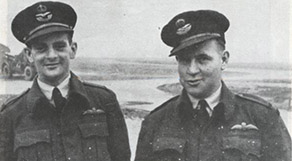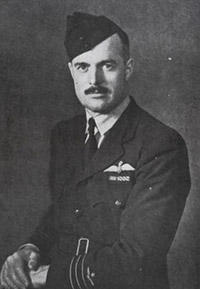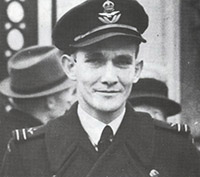 P/Os A. W. Doubleday and W. L. Brill whose crews were the first to complete a tour of operations on the squadron in 1942. They finished the war as Wing Commanders, each winning the DSO and DFC whilst Brill added a bar to his DFC later.
P/Os A. W. Doubleday and W. L. Brill whose crews were the first to complete a tour of operations on the squadron in 1942. They finished the war as Wing Commanders, each winning the DSO and DFC whilst Brill added a bar to his DFC later.In the period from its first operation on 12 March, 1942 to 28 August, 1942, the squadron became fully involved in Bomber Command's campaign against the German war industry, attacking 69 targets from which 26 crews were lost, including two flight commanders, Squadron Leaders C.L. Gilbert and J.W.E. Leighton.
Before their first raid was four months of intensive training under the guidance of:
Hubbard and Gilbert were both Australians who joined the RAF on short service commissions before the war, whilst Frank was a RAF officer attached to the squadron until succeeded by Squadron Leader J.W.E. Leighton, DFC, another Australian serving in the RAF.
The squadron's first operation to Emden on 12 March 1942 included five crews, led by Gilbert and Frank, which was not particularly successful because of bad weather conditions but all aircraft returned safely. This modest introduction to operations was followed by a series of attacks on U–Boat installations along the French coast, completed with only one loss.
The squadron played a minor role in Bomber Command's first major attack on a city when Lubeck was raided on 28 March 1942 and sent three crews to Rostock on 24 April 1942, devastating the city.
On 30 May 1942, Cologne became the first target for a 1000 bomber raid in which the squadron dispatched 18 crews, all returning safely from this highly successful attack, creating enormous damage to the German war industry. This attack was followed by 1000 bomber raids to Essen (1 June 1942) and Bremen (25 June 1942) in June, to which the squadron contributed 19 and 20 aircraft for the loss of two crews.
 P/Os A. W. Doubleday and W. L. Brill whose crews were the first to complete a tour of operations on the squadron in 1942. They finished the war as Wing Commanders, each winning the DSO and DFC whilst Brill added a bar to his DFC later.
P/Os A. W. Doubleday and W. L. Brill whose crews were the first to complete a tour of operations on the squadron in 1942. They finished the war as Wing Commanders, each winning the DSO and DFC whilst Brill added a bar to his DFC later.Pilot Officer W.L. Brill (pictured left, on the right) was the first member of the squadron to be decorated when he received an immediate award of the DFC, for his courage in the attack on Gennevilliers on the night of 29/30 May 1942.
Wing Commander W.L. Brill, of Narrandera, NSW is witness to the fact that the Lanc could take punishment. He came home from Brest on three engines, with one elevator shot off and 150 holes in her. Before that he had been hit by 27 incendiaries over Berlin and lost his rudder. Again, over Nuremberg, the blowing–up of another aircraft knocked out his port engine and rear turret and for a while he flew on two engines. Three times a badly damaged aircraft brought him and his crew home' (Hodson, J L, Bomber's Life [1944]). You can read more about Group Captain (his final rank) W. L Brill on the Australian War Memorial and the Australian Dictionary of Biography websites.
Pilot Officer A. W. Doubleday (pictured left, on the left) was also awarded the DSO and DFC (see RAAF Awards pictured below). His DFC citation reads: "Throughout his operational career he has shown outstanding ability coupled with a strong sense of duty. On numerous occasions he has pressed home his attack from a low altitude with a complete disregard for enemy opposition. Among objectives he has attacked are Emden, Le Havre, Cologne, Rostock, Essen and Kiel."

You can read more about Acting Wing Commander (his final rank) A. W. Doubleday on the Australian War Memorial website. They also have audio where he was interviewed by Ed Stokes.
The German anti–aircraft defences were considerably strengthened during 1941–42 with the searchlights and guns of the Kammhuber Line stretching along the whole of the enemy held coast. This made it increasingly difficult for bomber crews to return home safely from a raid. In support of the Kammhuber Line was a closely integrated network of ground controlled interception boxes each containing a ground controller who directed the enemy fighters onto a bomber as soon as it entered the area. A deep gun defended zone which worked in conjunction with these defences, completed the enemy network. 460 Squadron crews had become increasingly conscious of the German night fighters and numerous attacks had occurred.
Pilot Officer J.A. Falkiner's aircraft was attacked on the night of the 25th June, 1942 during the raid on Bremen, first by a Ju88, which his rear gunner, Sergeant R.C. Witney shot down, followed by attacks from two Bf109s.
On the 6th July, Sergeant J.C. Pearson's crew were attacked by a Bf109 whilst bombing L'Orient–Ile de Quiberon which his rear gunner, Sergeant P.J. Henderson destroyed. From the squadron records:
...The ME 109 banked up from under the Port quarter and came almost dead astern still banking. A burst of 120 rounds was fired into the enemy aircraft and the left wing dropped. The ME 109 turned over and dived into the sea. A flash was seen when the aircraft hit the water and small glare was observed. No shot were fired from the enemy aircraft...
On the 17th August, in a raid on Osnabruck, Henderson also claimed a Ju–88 as probably destroyed. From the squadron records:
...The aircraft was engaged in enemy combat and as a result the hydraulic system was rendered unserviceable and bullet holes were made in the starboard main and tail plane. There was general damage on landing. The rear gunner saved the aircraft by giving correct avoiding action when attacked even though the guns were unserviceable.
From the squadron summary:
...Whilst Wellington aircraft Z.1401 (M) piloted by AUS 403106 Sgt. Brittingham was returning from OSNABRUCK and had reached NORTHERN at 0008 hrs. a JU 88, carrying no lights was seen dead astern flying on the same level and about 300 yds. away. The Wellington was then flying at 10,000 ft. on a course 296.
There were no cloud and no moon but much ground haze. No searchlights were in operation. As the JU 88 came in from astern it opened fire and continued firing until it was 200 yds. distance away. At about the same time the rear gunner of the Wellington, AUS 400752 Sgt. Henderson P.J., opened fire and the aircraft made a shallow turning dive to port. The JU 88 also turned to port, climbed and disappeared. No hits were seen on the enemy aircraft and no claim made. As the Wellington was 120 miles N.W. of NOTHERN at 0012 hrs. the Wellington (M) was flying at 5,000 ft; on a course 296 when a JU 88 without lights was seen 500 yds. away on the port quarter flying on the same course and slightly above the Wellington AUS 400752 Sgt. Henderson P.J., opened fire at 100 yds with two 5 second bursts. At the same time the Wellington made a diving turn to port and then the starboard reaching cover in low cloud at 3,000 ft.
The rear gunner and the Wireless Operator saw hits on the enemy aircraft; a flash was seen and the enemy aircraft dived steeply with flames coming from the centre of the fuselage and smoke pouring from the engines. The JU 88 is claimed as probably destroyed and as a result of the encounter the Wellington's turrets, flaps and hydraulics operating the undercarriage was rendered unserviceable and the port main plane was holed. Some damage was done on landing but no member of the crew was injured.
Henderson was awarded a DFM, for his "Skill as a Gunner for safe return of aircraft".
Three nights before, in an attack on Düsseldorf, Sergeant E.K.F. Brasher's aircraft was attacked by a JU 88 which seriously damaged his aircraft but his rear gunner Sergeant K. C. Bennett gave their attacker a long, accurate burst which caused the fighter to go into a climbing turn to port, stalled and fell away enveloped in flames. From the squadron summary:
...As Wellington aircraft Z.1464 (K) piloted by AUS 40449 Sgt. Brasher E.K.F., was returning from the attack on DUSSELDORF at 0230 hrs. and flying at 14,000ft, and about 20 miles N.W. of DUSSELDORF, what was believed to be a J.U.88 was see approaching from the port quarter about 200 yards distant and slightly below of Wellington. The enemy aircraft immediately opened fire with cannon and machine guns, firing in all a burst of about 4 seconds and scoring hits amidships on the Port side about 10ft. astern of the astern hatch and penetrating the armour plated doors. The Wireless Operator, AUS 401685 Sgt. Forrest J., who was standing in the astro hatch was wounded in the thighs.
The Captain put the Wellington into a steep dive and the Rear Gunner, AUS 407992 Sgt. Bennett K.C., rotating his gun turret 45 degs. to port, opened fire on the enemy aircraft which was 70-100 yards distant and slightly above. In all one burst of 6-7 seconds was fired and tracers were seen entering the enemy aircraft at the wing roots and from of fuselage which went into a climbing turn to port. A yellowish green flame broke out at the root of the port wing and the aircraft stalled and fell away enveloped in flames and is claimed to have been destroyed.
As a result of the encounter the Wellington sustained damage to fabric and geodetics. Some bullets entered at the rear end of the bomb bays and emerged through the front turret causing considerable damage to the wiring and putting the hydraulic system out of action so that the emergency system had to be used for lowering the undercarriage, it was also impossible to close the bomb doors.
Brasher received an immediate award of the DFM, for bringing his badly damaged Wellington back to base but was killed in action two days later.
On 22nd September, 1942, Flying Officer D.T. Galt was shot down in an attack on Stuttgart but evaded capture, returning to England six weeks later. He was awarded the DFC for "displaying gallantry and coolnest whilst flying" in February 1943. He was transferred to Coastal Command but was lost on his first trip with his new squadron (461) in August 1943.
In September 1942, the squadron temporarily left the line to re–equip with multi–engined Halifax bombers but on the 20th October it was decided to re–arm the squadron with Lancasters. The crews were sorry to lose their faithful Wellingtons but the change from twin to four engined aircraft, symbolised the changing nature of RAF Bomber Command's strategic campaign.
1943 heralded the first year in which the Allies were on the offensive and the month of March saw the commencement of the battle of the Ruhr which would do enormous damage to the heart of the German war machine, an area described by the crews laconic humour, as "Happy Valley". It was fortuitous that at this particular period when the crews were to be called upon to make enormous sacrifices, there came two officers whose appointments were almost simultaneous and whose contributions were of incalculable value to the squadron.
The first was Group Captain Hughie Edwards as Station Commander, the first airman to win the VC, DSO, DFC, in WWII. His courage, leadership and inspiration was largely responsible for the extraordinary operational record the squadron achieved for the remainder of the war.
 Wing Commander C. E. Martin, DSO, DFC.
Wing Commander C. E. Martin, DSO, DFC.About the same time Wing Commander Chad Martin DFC, was appointed Squadron Commander in succession to Dilworth and was the first graduate (No 1 Course) of the Empire Training Scheme to Command a squadron in Bomber Command and he likewise set the highest standards of leadership.
The Battle of the Ruhr officially opened on the night of the 5th March, 1943 when 369 aircraft bombed Essen under perfect conditions, the squadron sending ten crews without loss. In the course of the next four months until the 25th July, 1943 when this campaign concluded, the squadron crews visited the heavily industrialized cities of Essen six times, Duisburg on five occasions and Cologne four times as well as the other Ruhr targets of Dortmund, Bochum, Düsseldorf, Krefeld, Wuppertal, Oberhausen, Mulheim and Gelsenkirchen. In addition, the young crews were called upon to make other far reaching attacks on Berlin, Nuremberg, Munich, Stuttgart, Spezia, Pilsen, Turin and Hamburg.
The Squadron lost three crews in the attack on the vast Skoda works at Pilsen and four nights later another three crews were lost in a heavy attack on Berlin. In addition to the aircraft lost on this raid, another six were damaged, among them Flight Sergeant H.L. Fuhrmann's whose Lancaster was badly damaged by fire from an armed ship while flying over the Baltic. Both he and his navigator, Flying Officer C. B. Anderson were seriously wounded but despite these difficulties they managed to fly their aircraft back to Britain where Fuhrmann made a crash landing and immediately collapsed from his wounds. Fuhrmann received an immediate award of the DFM, and Anderson the DFC, for their courage, skill and fortitude.
 F/Lt. A. B. (Paddy) Boyle, DFC and bar
F/Lt. A. B. (Paddy) Boyle, DFC and barFlight Lieutenant Paddy Boyle was a most interesting character, having served his time as a jackeroo in the outback of Queensland before his enlistment and was consequently as tough as nails. Squadron life to him was a perpetual challenge and adventure and he finished the war as a Squadron Leader being awarded the DFC and bar in the process. He came to the squadron in July 1942 and lost his crew almost immediately when they operated with another pilot. In all he had over 60 airmen fly with him on his first tour, a most unusual experience as in most cases a crew of seven airmen stuck rigidly together throughout their tour. When nearing the end of his first tour his plane was hit by incendiaries from above. He made a profound statement on his return from a later raid that operations had convinced him of three things: